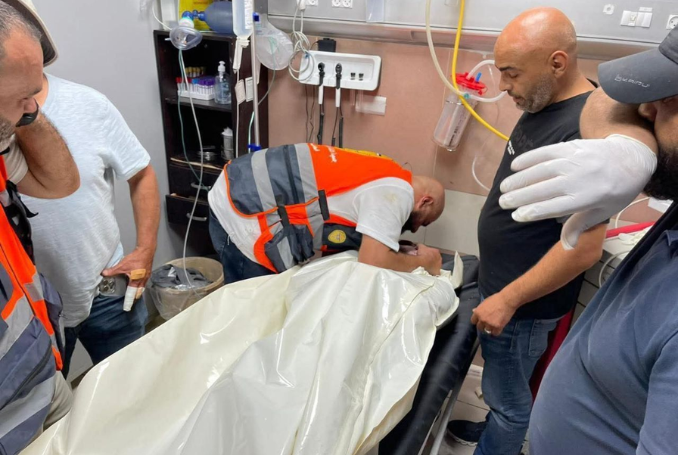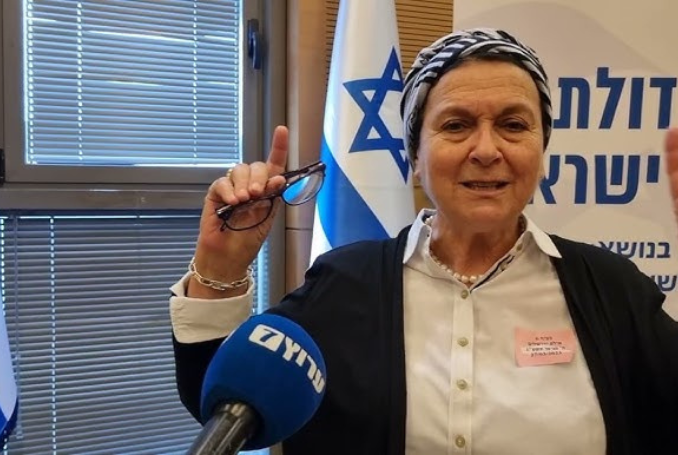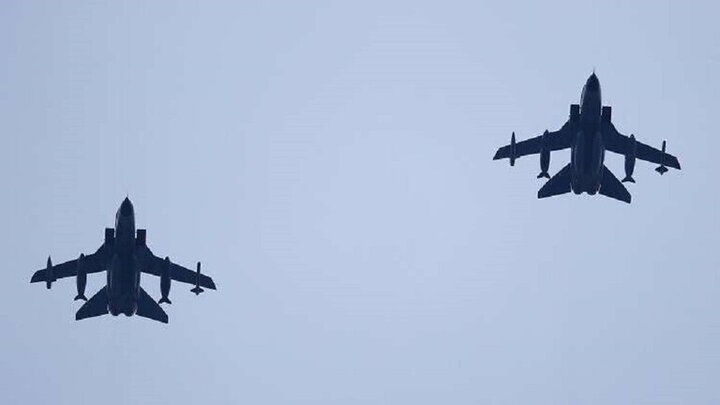By Benay Blend
Given their reluctance to report anything other than the Official Story, it’s not enough to ask that mainstream news cover these stories from Palestine.
On July 11, 2025, illegal Israeli Jewish settlers murdered two Palestinians in the town of Sinjil, north of Ramallah in the Occupied West Bank. 23-year-old Muhammad Shalabi and US citizen Saif Eddin Muslat are the latest victims of the Zionist plan to ethnically cleanse all Palestinians from their homeland.
Amid escalating settler attacks across the region, Muslat’s death drew particular attention, perhaps because of his US citizenship as well as his particularly violent death.
Murdered while visiting relatives on his family’s farm, his relatives attest that settlers beat Muslat then prevented ambulances from reaching him for several hours. Zionists also fatally shot his friend, leaving him to bleed out, according to the Palestinian Health Ministry.
Settlers are often depicted as armed and dangerous while somehow being separate from the government. In fact, these attacks are occurring under full military protection and with political approval from the Zionist regime.
Shortly after news broke of the tragedy activist circles took to social media and beyond to lament that most mainstream media had ignored the tragedy, while at best giving it only a few lines.
Actually, New York Times (NYT) reporters Aaron Boxerman reported from Jerusalem, and Fatima AbdulKarim from Ramallah, West Bank did cover the incident, but unfortunately with the usual slant notable in such articles by the Times.
The very title wreaks of so-called “two-sidesism,” meaning that reporters treated violence committed by both sides as somehow equally violent and regrettable. Seemingly a reversal of Trump’s infamous defense of white nationalists during their participation in a 2017 rally in Charlottsville, North Carolina—“There are very fine people” on both sides, he said—the Times referred to rock throwing on the part of Palestinians against armed settlers with lethal weapons as a “clash.”
Perhaps this bias happens because very often Western media rely mostly on Israeli sources, thus refusing to seek out other witnesses for their story. Hence the coverage comes out this way: “Mohammad Shalabi, 23, was shot and killed during the clashes, according to Palestinian health officials. It was not immediately clear who shot him: Both armed settlers and Israeli forces were on the scene.”
In the case of Al Jazeera journalist Shireen Abu Akleh who was shot in the back of the head by an Israeli soldier, Israel at first denied knowing the cause of her death, then claimed that it was not intentional on the part of the shooter.
“The Israeli military said in a statement that the violence began on Friday when Palestinians hurled stones at Israeli civilians, lightly injuring two of them,” the NYT article continues. “Violence has soared in the West Bank since the start of the Israel-Hamas war in Gaza.”
Thus, there is no context given for Palestinian resistance, in this case in the form of stone throwing, no mention of the Nakba (catastrophe) of 1948 when Israeli violence towards the Indigenous population actually began.
There is the same lack of framework pertaining to the entity’s genocide on Gaza, a siege (not a war) on the total population, not just Hamas, all done in the hopes of displacing inhabitants of the entire Strip.
Although there is some testimony given by Palestinian witnesses later in the article, it focuses solely on “extremist Israeli settlers” who are assumed to be acting on their own.
As Aaron Turgeman wrote in 2015, the game of “Blame the Hand [the settlers] has been played since the early days of militant Zionism,” a move which allows the entity to carry on its colonization project with impunity. In reality, he continues, it is the case “that the hand does not operate by itself. It is the head that moves it. And the head is the Israeli government, representing Israel’s Jewish population.”
Recalling an earlier incident, the NYT article concludes with a recap of another Palestinian American boy who was murdered at the hands of Israeli forces. In April 2025, Amer Rabee, a 14-year-old boy from New Jersey, died after Zionist soldiers shot him 11 times in the town of Tummus Ayya, north of the city of Ramallah.
The justification? NYT reporters conclude in a chillingly straightforward manner: “The Israeli military said he had thrown stones, labeling him a terrorist.” Apparently, his family disagreed, but still the reporters give no hint that perhaps death by eleven bullets is not a fitting penalty for throwing stones.
Writing for Palestine Chronicle, South African journalist Igbal Jassat asks: “Has Slaughter of Palestinians in Gaza Become ‘Normalized?’” Judging by articles that do not question the legality of extrajudicial killings not just in Gaza but in all of occupied Palestine, the answer must be “yes.”
“Zionism has always relied on the support of Western powers and that support relies on the projection of image,” Turgemon writes. Western journalists buy into this ploy by repeating the regime’s refusal to take responsibility for any of its crimes.
Nevertheless, there are choices that extend beyond the mainstream. In “A New Generation Bears Witness,” Ramzy Baroud, founder of Palestine Chronicle, describes an emerging group of young journalists in Gaza whose mission is to cut through the myths propagated by Western media.
For example, compare how these journalists cover this story with the ways that mainstream platforms report the news.
As for the latter, there was no context, no effort to question information provided by the Zionist regime. Although there might be a few comments from Palestinian observers, these are mentioned so briefly that they carry very little weight.
Palestinian reporters, along with those sympathetic to their cause, provide context and a back story that makes clear how this was no random act.
According to Palestine Chronicle staff, the murder of Shalabi and Muslat occurred amid an escalation of settler and military violence along the central and southern West Bank. Israel’s genocide in Gaza, now in its tenth month, also provides a backdrop for this story.
Lebanese pan-Arabist source Al Mayadeen explained further that these attacks are part of the entity’s ongoing efforts to occupy more Palestinian territory.
In response to this new wave of Israeli aggression in Gaza and across the West Bank, Palestinian filmmakers are proving that art imitates life, and sometimes vice versa. More importantly, these films provide another lens through which to counter Israeli hasbara (propaganda).
For instance, Watermelon pictures offers a wide variety of films that depict through documentary and fiction the lives of contemporary Palestinians who resist Israeli theft of their land and lives.
Included on their website, Farah Nabulsi’s The Teacher follows a charismatic instructor (Bassem) whose son died from neglect while detained in an Israeli prison. To compensate, he takes two young men under his wing. After the oldest is shot by a settler who seems determined to burn his family’s trees, Bassem takes the culprit to court, but his efforts are in vain because there is no justice for Palestinians under Occupation.
In this case, art foreshadows life, as Nabulsi wrote the film script several years ago, only to have it released in 2024. Still, the only change for Palestinians is the escalation of violence that has been directed against them since the Nakba (catastrophe), an event funded by Western governments but ignored and/or misreported by the media.
Given their reluctance to report anything other than the Official Story, it’s not enough to ask that mainstream news cover these stories from Palestine. Given their unqualified reliance on Zionist narratives, it is perhaps best that they don’t.
On the other hand, there is an abundance of credible sources that provide context for these tragic stories. Mondoweiss, Al Mayadeen, Palestine Chronicle, Electronic Intifada, Resistance News Network on Telegram, these platforms and more rely on narratives told through various Indigenous lenses.
“Despite the devastation in Gaza, a new understanding of the tragic realities there and throughout Palestine is emerging,” Baroud writes. “These lessons will endure. A key lesson is that Palestinians, like other victims of conflict and colonialism, are not inherently dependent on the West for their truths to be known and acknowledged.”
For those who are looking for credible narratives and backstory, it’s time to break their dependence, too, on Official News.



